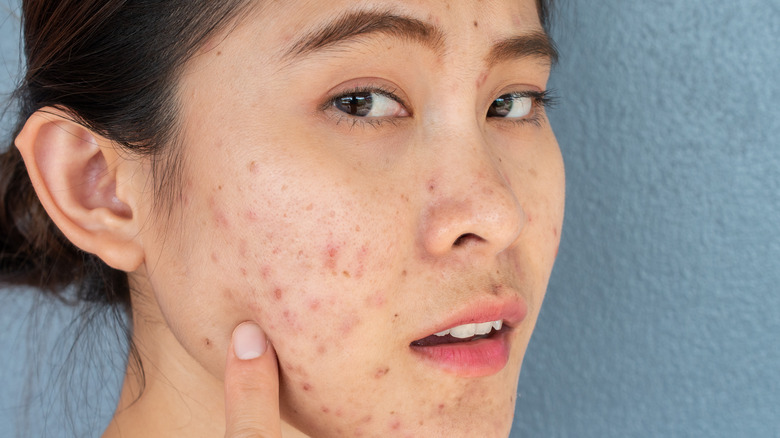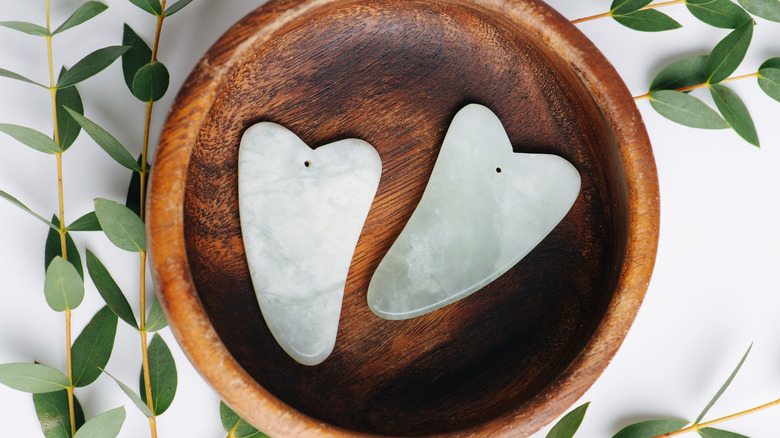Why You Should Make Sure You're Always Using A Clean Gua Sha Tool
When was the last time you cleaned your gua sha tool? If you can't remember, it's time to do it more often. Just like your towels and makeup brushes, gua sha tools can harbor dirt and bacteria. Improper or regular cleaning can put you at risk for skin infections, especially if you have a weak immune system or underlying conditions. The risk is also higher in those with skin inflammation, wounds, burns, and skin disorders, according to the MSD Manuals.
Gua sha has been used as an alternative treatment for thousands of years. This technique involves massaging the skin and muscles with a stone made of jade, amethyst, quartz, or other natural materials. Depending on your needs, you may use it to relieve muscle tension, neck or back pain, migraines, insomnia, or fatigue. Alternatively, you can massage your face with a gua sha tool to reduce swelling and get your sinuses draining, suggests the Cleveland Clinic. This form of therapy is believed to improve circulation and ease localized pain, notes a 2007 study featured in the journal Explore.
With that in mind, it's essential to thoroughly clean your gua sha stones before using them on the skin. Otherwise, you might end up transferring bacteria from your back or legs to your face — or the other way around.
Gua sha tools can harbor dangerous bacteria
The human skin is home to trillions of bacteria, yeasts, and other microorganisms, including pathogens like Staphylococcus aureus and Propionibacterium acnes. Some are beneficial, while others may cause dermatitis, acne, eczema, and other skin diseases, per Frontiers in Cellular and Infection Microbiology. For example, Propionibacterium acnes is responsible for the development of acne vulgaris, a skin condition that affects 10% of the population, according to 2019 research published in the journal Microorganisms. This microbe can trigger or increase inflammation, causing pimples and acne cysts.
Makeup brushes, jade rollers, and gua sha stones come in direct contact with your skin. Therefore, they can become contaminated with microbes. If you don't clean them regularly, you could end up transferring bacteria from one area to another. What's more, these tools can harbor dead skin cells, dirt, makeup residue, or mold. For example, dirty makeup brushes can lead to acne breakouts, fungal infections, or skin rashes, warns the American Academy of Dermatology Association. The same goes for gua sha tools, regardless of what they are made of.
The right way to clean your gua sha tools
While there are no set rules on how often you should clean your gua sha stone, it's best to do it every few days, suggests RAS. The beauty retailer recommends cleaning your face rollers and gua sha tools with a soft, dry cloth before and after each use. For thorough cleaning, rinse them with soapy water or wipe them with a soft, damp cloth every three to four days. Alcohol-based sanitizers will do the trick, too. When you're done cleaning, allow your beauty tools to dry and store them in the refrigerator.
Note that it's perfectly fine to clean your gua sha stone after each use, according to the beauty brand Mount Lai. Use mild soap and water to remove bacteria and then let them dry or wipe them with a soft cloth. You can do the same with your jade roller. If you use your gua sha tool on the neck, back, legs, or other body areas, clean it thoroughly before using it on your face. Regular cleaning will extend its lifespan and prevent the spread of acne-causing bacteria and other germs.


